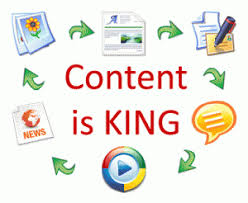If content is king, then content strategy must be the queen. Content strategy lays the foundation of any website. Done right, it can help you improve search engine rankings, convert visitors into customers, and build a community of loyal followers. It can also save you time: Once you’ve created quality content, you can recycle it and repurpose it as needed to keep your audience engaged.
But content strategy isn’t just about saving time or improving search engine rankings. Its true value is that it helps you create better content for your website. The content strategy process helps you ask the right questions (Is my content effective? Is it user-centric?) and develop a clear direction for your blog or website. That way, when you sit down to write blog posts, podcasts, graphics, or video content, you have a clear idea of what you want to say and how to say it in the best way possible.
What is a website content plan?
A website content plan is a document that outlines the content you want to target on your website and the marketing strategies you will utilize to achieve it. This includes topics of interest, content types, audience targeting, keyword research, and more.
– On a content plan, define your target audience and create content that speaks to their interests. This will help you create content that resonates with your audience’s preferences and interests.
– Develop an organized content plan and schedule for creating, editing, and publishing content. This will help you stay on track and not get overwhelmed by the content creation process.
– Utilize a variety of content types such as blog posts, videos, and infographics to keep readers engaged. These content types vary widely in terms of format and frequency, making them an effective way to share content on your website.
What is content creation?
– Create content for your website in a way that it is useful and engaging for your target audience.
– When planning content for your website, take into consideration the target audience of your content. This will help you create content relevant to them and engage with them. Also, research topics relevant to your business and create content around it. This will help your website build trust among its readers and build its credibility.
-Create content consistently to build trust with your readers. Work on creating quality content consistently to provide valuable insights and information to your audience.
-Effectively optimize your content for search engines by using keywords and meta tags. This will help search engine bots find and index your content more easily.
What content should I include on my website?
-Create content that is relevant and interesting to your target audience. This content should be engaging and informative, drawing readers’ attention and interest.
-Offer helpful and informative content that adds value for readers. This content should be valuable, offering tips or insights that can help readers improve their lives or make informed decisions. It can also include information on topics of interest or importance to your target audience.
-Use high-quality visuals to draw attention and increase engagement. This content should be visually appealing, using photos, graphics, and other visuals to captivate readers’ attention and help them connect with the content more easily.
-Utilize interactive elements such as polls, quizzes, and videos to keep visitors engaged. These elements allow visitors to interact with the content in a way that enhances the experience and helps encourage continued engagement. In addition to providing useful information, these elements can also increase page views and conversions by driving interest in the content.
-Optimize content for search engines by including keywords and SEO tactics. This includes keyword research, writing content for search engine algorithms specifically, and incorporating relevant keywords into titles, headings, and other elements of the content. By doing this, you’ll ensure that your content is found by search engine users when they search for it.
Content Creation Ideas
Ideally, content creation involves creating content relevant to different stages of the buyer’s journey. You can use video and audio content to engage readers. User-generated content is another way to boost your website’s content engagement. By sharing relevant industry news and trends with your readers, you can foster a sense of community and inform readers of topics they care about. Additionally, you can ask questions and encourage feedback from them on topics of interest to create a vibrant discussion on your website. By creating engaging content for your website, you can increase your website’s visibility and optimize its performance.
1. Blogs
Blogs are a great way to engage your website visitors and help them learn about your business or niche. They are especially effective at explaining complex topics in a clear, engaging way. You can use blogs to share stories, promote your products or services, and link out to other relevant content. But creating good content that is interesting, informative, and visually appealing is key to drawing blog readers to your post. It’s important to keyword-tag your blog post titles and use relevant keywords so search engines can easily find and index them. By creating quality content that is unique to your blog niche, you can help improve its search engine rankings and attract new readers.
2. Podcasts
Podcasts are a great way to engage and inform your audience. They can be a cost-effective way of providing valuable information in an entertaining way. Creating podcasts requires minimal effort and can be done from the comfort of your home. You’ll need to decide on the topics you want to cover, the format of your podcast, and how long it should be.
Podcasts are a great way to build relationships with your audience and establish yourself as an expert in your field. They are also a great way to stay informed about trending topics and industries. Whether you’re creating content for your website or social media channels, podcasts are a great way to add depth and value to your content strategy.
3. Video
Video is a great way to engage with your website visitors and create memorable experiences. It can be used to showcase products, services, or ideas in an interactive and informative way. Creating video content can be as simple as recording yourself talking about a topic, or it can involve animation, special effects, and more. Adding videos to your website can help promote engagement and build trust with customers. By sharing your company’s story in an engaging way, you can strengthen your brand and increase conversions.
Videos are an effective way of engaging with your audience and creating content that is relevant to them. Besides, videos are easy to share on social media platforms such as Facebook and Twitter, which helps reach a large audience quickly. Overall, video content plays a vital role in online marketing strategy and is worth the effort if you want to engage with your target audience and provide them with quality content.
4. Graphics
Graphics are a great way to add visual interest and engage readers. Using infographics, charts, and diagrams can help to break up text and make complex ideas easier to understand. Images can be used to highlight key points or illustrate stories you’re telling. Additionally, videos can be used to provide an immersive experience for viewers or demonstrate a process or concept in real time. Animation can also be used to create unique content that stands out from the competition. These diverse forms of content can help with audience engagement, communicate complex information in a compelling way, and build a brand’s reputation and credibility. It is vital for content creators to use graphics effectively to ensure their content is engaging and effective.
The Content Creation Process
– Create content that’s relevant and interesting to your target audience.
– Ensure your content is keyword- optimized, using keywords that are relevant to the content topic.
– Research the topics and ideas of your content pieces before writing them. Doing this will help you create unique content with valuable insights for your audience.
– Brainstorm content ideas that are unique and creative. You can also consider asking for input from other specialists in the field or audience. This will help you create content pieces that are informative, insightful, and engaging for your audience.
– Write content pieces with a consistent voice and tone. Make sure to focus on the main points of your post or article and write in an engaging manner.
– Optimize content for search engines to increase visibility. This includes title tags, keyword tags, and meta tags that are relevant to the content piece’s topic.
1. SEO Research
SEO research is an essential step in creating engaging content for your website. Key elements of SEO research include keyword research, analyzing competitors’ content, and understanding the target audience. In order to create high-quality content relevant to the needs of your target audience, content must be written to address their concerns and include keywords that search engine algorithms use to rank websites. Content should also include visual elements such as images, videos, or infographics to make it more appealing to readers. This type of content can help draw in a audience and engage with them on a deeper level. It is important to remember that search engine results can be influenced by many factors, including the quality of your content, so taking the time to create engaging content will pay off in the long run.
2. Ideation
The ideation process is the process of coming up with content ideas that will engage and interest your audience. When creating content for your website, it’s important to brainstorm topics relevant to your industry or business and make a list of potential ideas. You can also research trends in your industry and search for ways to incorporate them into your content. For example, if you write about marketing strategy, you may want to share some of the statistics you’ve gathered from your research. Additionally, engage with other content creators to get inspiration for new ideas or angles on existing topics. This will help you create content that stands out from the competition.
3. Writing
Writing engaging content for your website begins with understanding your target audience and what type of content they need to be engaged. Write in a conversational tone that is easy to understand, and use strong headlines and subheadings to draw readers in. You can include visuals such as images, videos, and infographics to break up the text and help tell your story. Additionally, you can use data, research, and case studies to back up your points and establish credibility. By writing engaging content, you can help improve the online experience of your audience while engaging them with your brand message.
4. Editing
Editing content is an important part of the content creation process. It can make the difference between engaging, high-quality content and lackluster copy. When editing your content, consider spelling, grammar, and clarity as well as other elements such as flow and readability. In addition, be sure to assess how your content looks on the page and how readable it is. Finally, ensure that all of your facts are accurate and that your sources are trustworthy. Without thorough editing of content, it can be easy for mistakes or inaccurate information to slip through and undermine the credibility of your content.
7. Promoting Content
Promoting your content is an essential step in the content creation process. Creating social media posts, submitting to directories, and sharing on other websites can help you get more exposure for your work. Consider repurposing your content into different formats, such as blog posts, infographics, and whitepapers. Use analytics tools to track the performance of your content and adjust your strategy as needed. It’s important to remember that promotion is only part of the equation – quality content will always be vital in gaining audience and establishing a reputation.
Analyzing Your Content
To create content that is engaging and valuable for your website audience, it’s vital to know your target audience and create content that appeals to them. By using metrics like engagement rate and click-through rate, you can track the success of your content and analyze trends in your industry. Additionally, you can monitor feedback from users to determine how your content is performing. By taking these steps, you can create content that is both informative and entertaining for your audience.
Frequently Asked Questions
What is the best way to create content for a website?
Creating content for a website can be an intimidating task if you don’t know where to start. Here are some of the tips that can help make it easier:
1. Start With A Clear Idea Of Your Audience: Before you start writing content, take some time to think about who your target audience is and what they’re looking for. This will ensure that you create content that resonates with them and keeps them engaged.
2. Choose Relevant Topics: After you’ve identified your target audience, research what topics would interest them and choose those for content creation.
3. Keep It Easy To Read And Understand: Regardless of how knowledgeable your audience is, make sure the content is written in an easy-to-understand language without overusing jargon.
4. Include Visuals To Engage Your Audience: Use visuals such as images, videos and infographics to make content more engaging and visually appealing for your audience.
5. Optimize Content For SEO: Finally, optimize the content by including keywords in titles, headings, and meta descriptions so that search engine bots can easily find it.
Where should I get my ideas from when creating content for a website?
When creating content for a website, the best way to come up with ideas is to look to your customers and audience. Look through customer reviews, surveys, and feedback that they have given in order to understand their needs and interests. This will help you target content towards what people are looking for and engage them better.
You can also browse other websites in your industry for inspiration, take advantage of trends and topics that are currently popular on social media, and monitor content from thought leaders in your niche that resonates with their audience. Additionally, keyword research tools are great resources to help identify topics that are likely to get more search engine traffic. All of these sources of information can provide great content ideas for your website.
What are the different types of content that can be created for websites?
Creating content for websites can be a great way to engage and inform your audience, as well as help you drive website traffic. Content creation involves creating content of different types such as blog posts, articles, product descriptions, tutorials, vlogs, interviews, infographics and podcasts.
Text-based content is great for providing detailed information on topics that are relevant to your website. This content can include blog posts, articles and product descriptions. Video content like tutorials, interviews and vlogs are great for visual learners. Infographics provide complex information in an easy to understand format and podcasts are great for sharing stories and advice on topics related to your website. Whatever type of content you decide to create, make sure it is of high quality and provides value to your audience.
Conclusion
To ensure that your content marketing strategy results in optimized website content, you must first create a content plan for your website. The first step in content creation is understanding what type of content your target audience wants to read. This requires thorough research on search engine optimization and target audience keywords. Once you’ve finalized the type of content you want to create, writing the blog post or web page is the next step. Editing and proofreading are vital parts of content creation, and we’ll cover them in-depth later in this blog post. Finally, once your content is ready, be sure to promote it across social media and search engine result pages to get the most visibility possible!



